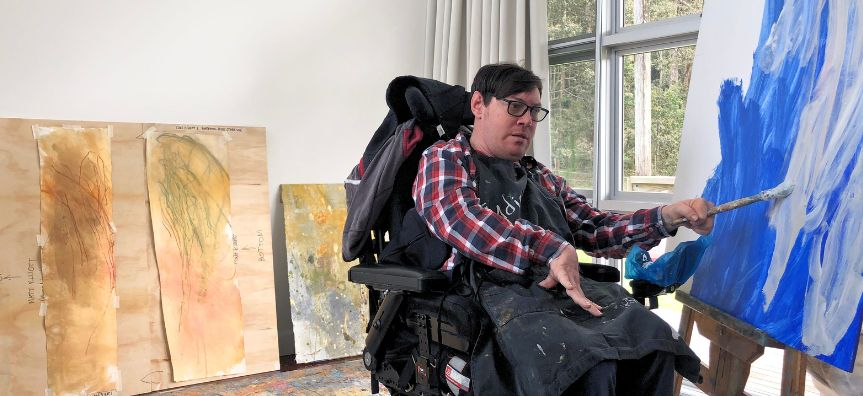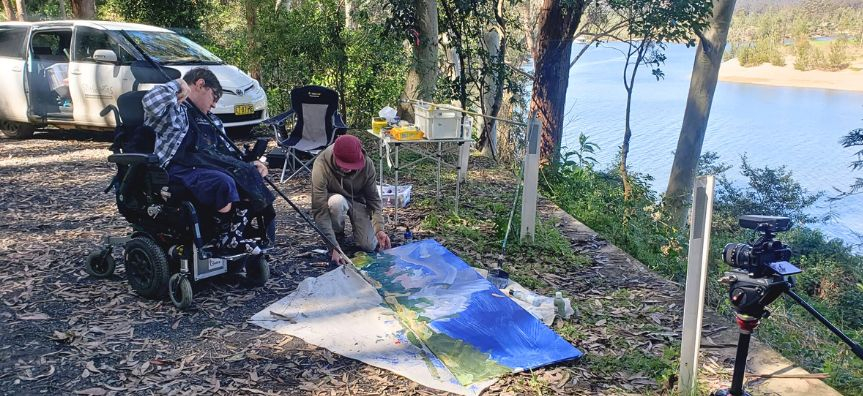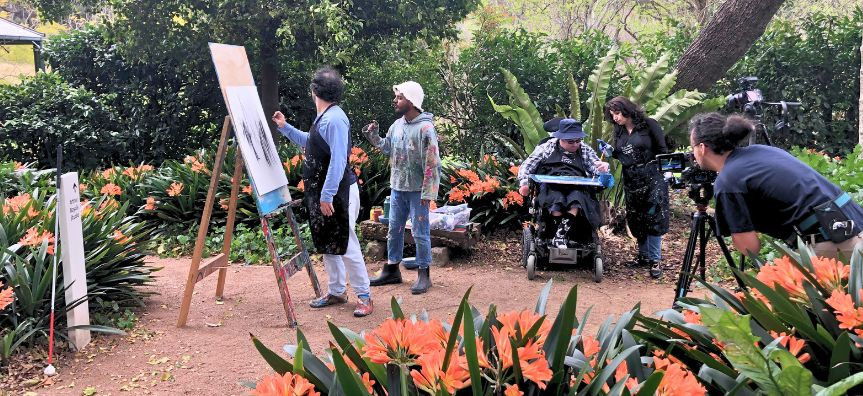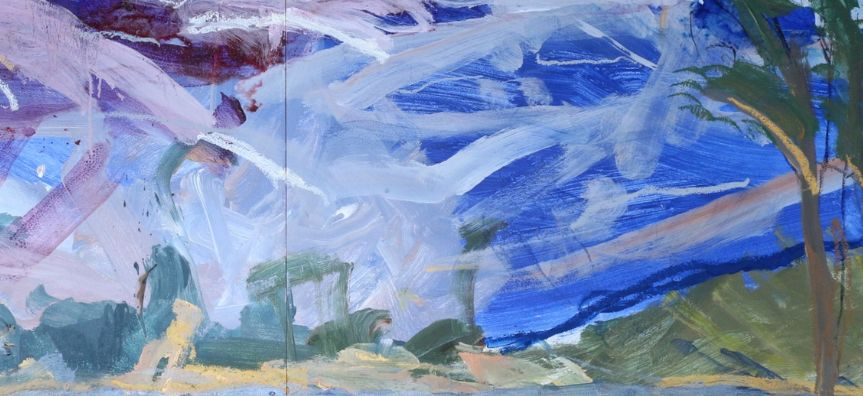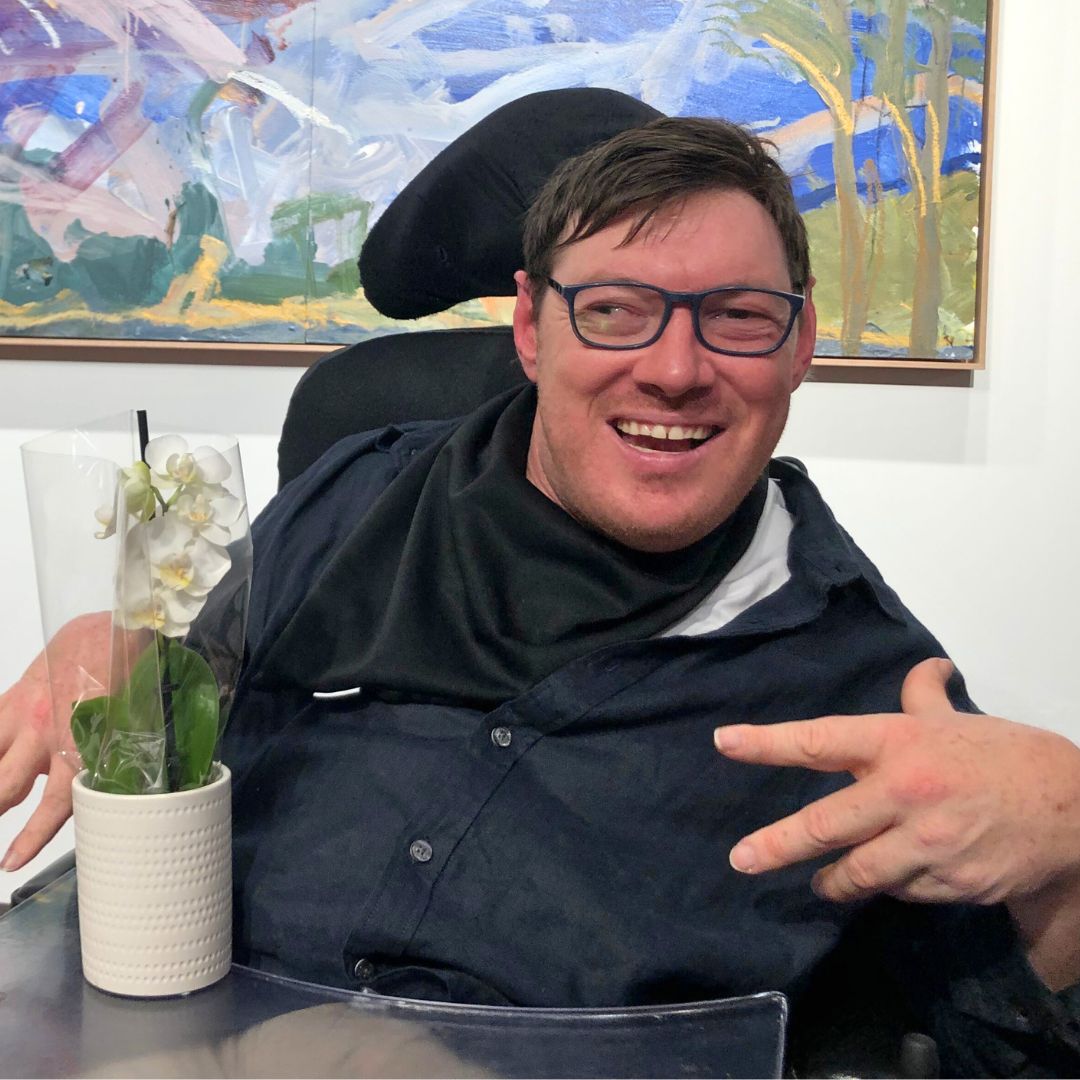
Matthew Elliott is a practicing artist living with Cerebral Palsy.
As an abstract landscape painter and drawer, Matthew has said he is determined to not let his disability hinder what he wants to do in life. He has been an active member at Studio ARTES Northside for 21 years and has been consistently exhibiting his art in their annual exhibition program.
Recently Matthew has been actively seeking exhibition opportunities and applying for art prizes – including winning first prize in the Disability Category of the Hawkesbury Agricultural Show Art Prize (Sunset over Uluru, 2021) and exhibiting alongside one of his artist inspirations, David Collins, in ‘The River’ group exhibition curated by Alexandra Mitchell, at the Cottage Gallery, Brooklyn (On the Harbour, 2021).
Matthew is a Northern Beaches Studios artist, working at Curl Curl Creative Space.
Apply for a studio at one of Council's Creative Spaces. Applications close Thu 31 Oct, 2024.
You’ve been described as “an abstract landscape painter and drawer who has a fascination with dream states, creating lucid mindscapes”.
Can you explain this a bit more? How much are you painting the landscape you see in front of you, and how much are they interpretations of what you see?
I like painting landscapes because I feel free being out in nature and I feel like I can do what I want when I’m painting. My landscapes are abstract and gestural in nature partly due to my disability (Cerebral Palsy), but my disability gives me my own unique painting style and my brushstrokes reflect my range of movement. In my paintings I am trying to capture the raw, emotive essence of the landscape more than what it physically looks like. Sometimes I go and look at nature and draw what I can see around me (the horizon, trees, sky, landmarks and objects in the scene). Sometimes I paint from my mind or how I’m feeling at the time (how the landscape makes me feel and how my inner emotional world is).
You’re painting process has been described as “harnessing (your) imagination and entire physicality to paint and draw on both large and intimate scales.
As described in the question above, your imagination is evident in your work. As someone who uses a wheelchair with limited fine-motor movement, can you describe the techniques you use to paint at both small and large scales?
For small scale artworks I make them on my table on my wheelchair, up to A3 in size. I use small brushes, pencil, charcoal and oil pastel, and also mix dye pigments and salt to create nice colours and textures.
My large scale works are made on the floor on unstretched canvas or plywood boards. I use my brush on a long pole so I can reach down to the floor and move all around the painting with big washy brushstrokes.
For medium sized works (and when I’m resolving a piece) I like to work at an easel or against a wall, sometimes with paint, sometimes I draw over the top with oil stick.
As part of a residency at Bundanon in 2022, you and Luke Abdallah immersed yourselves in the landscape and created a body of work inspired by the experience. This resulted in an exhibition in 2024, Bundanon: Painting a Promised Land.
What was it like to paint at a location as revered as Bundanon?
It felt like I was on top of the mountain while I was painting there! We got to go inside Arthur Boyd’s painting studio where he used to make his art and saw all his last artworks and painting tools. It made me feel like I was really there with him. It made me feel like a real artist.
To help understand your painting process a little more, what did you create while at Bundanon, and what did you then do to have the artworks ready for the exhibition?
I made one big artwork which was very special. It was a panoramic scene of the Shoalhaven River. We stopped on the side of the road with a nice view of the river and I painted for a couple of hours en plein air. I painted in the sky and the background and the river. Then when I came home to Sydney I worked on the piece for a number of weeks, adding a sunset to the sky and some trees in the foreground (at the easel).
I also did a series of small panoramic landscape studies, a charcoal drawing in Arthur Boyd’s Garden and a big painting of the view from my studio window (which was recently a finalist in the Northern Beaches Environment Art Award). I also started on some artworks collaborating with my artist friend Luke Abdallah, which we finished off over the following months. We had to get all the artworks framed once they were finished to get ready for the exhibition.
In 2023 you created a short film with Zachariah Fenn, On The Road. This documented your artist residency at Bundanon, and was selected for the Focus on Ability Film Festival.
Why was it important for you and Zachariah to make this film? What message or story do you hope viewers take away from it?
I like using film as a way to make people aware of disability. I want to show that people with disability can do what they want, and how they want to do it. I have a disability but that will never stop me. The Bundanon residency was a good chance to show that to everyone, that you can go out there and do it.
On The Road shows you painting en plein air.
What do you enjoy about painting in the open environment, and what role does it play in your practice? Further, what techniques do you use when painting outdoors?
I like smelling the fresh air and being out in nature. It makes me feel free. I love going bush, especially where there’s water.
Recently I’ve been exploring Manly Dam and the Harbord Lagoon, near Curl Curl Creative Space. I take photos and do some drawing, then I use the drawing to make a large painting. When I’m painting outdoors I use long poles with brushes on the end to paint on the ground. Zac helps me dip my brush in paint and mix colours. I can cover a lot of the board if I’m using big thick brushes. I usually start with the sky and the background at the top, then work my way down to the foreground.
Your works are beautifully layered and use a number of mediums like paints, pastels, and inks. However, they’re not overworked and often feel very spacious, like we’re in the landscape itself.
How do you know when to stop working on a painting? Do you ever do too much, and what do you do if that happens?
When I am happy with it, and when I know I am nearly there, I stop. I try to have a look at my artwork (at a distance) to think about whether what I’ve done is good. It takes a long time and effort to build up the layers so I have a lot of time to think about the overall composition. I always try to get the background finished before I move to the middle ground and then the foreground.
You regularly collaborate with other artists like Zachariah Fenn and Luke Abdallah.
What do these collaborations mean to you? How do they inform your practice, and what do you enjoy about the process of working with others so closely?
I like making art with (Blind Artist) Luke Abdallah because he has been a close friend for a long time at Studio ARTES and he has similar painting approaches and techniques. Sometimes I like to use the same painting tools that Luke does and we work on a big painting on the floor together. It’s good to share ideas with other artists and it helps me to try new things I wouldn’t usually do.
Zac (from Studio ARTES) supports me when I make my art and has done so for the last five years. He has helped Luke and I to create our artwork on a much bigger scale.
In 2018 you were awarded a 12-month professional mentorship with Studio A. You’ve also been mentored by the late artist Greg Warburton, who you then inspired to work with Studio Artes.
How important were these mentorships for you? Can you share some of the key lessons you took from your time with Studio A and Greg?
I knew Greg since I was a kid. Greg was a good man and a great artist. I like his artwork and he always said, “you can have a go”, and told me to never give up. When I won the Professional Pathways award from Studio A (2018) I thought “I am finally getting there as an artist.” It was a positive step to get to where I want to be and they helped me to build on my Artist profile and have my first solo art exhibition, which was here at Curl Curl Creative Space in early 2021.
What would you say to other people thinking about finding a mentor, or thinking of being a mentor?
Put your mind into it and tell yourself, “You can do it!”. I wouldn’t be where I am today if it weren’t for the mentors I have had, and it’s encouraging to know you have support from people around you. I still hear Greg telling me to “never give up.”
You’re a founding member of Little Umbrella Collective, self-described as “an inclusive collective of rag-tag Artists.”
How did this collective come together, and what does this type of community mean for you?
Little Umbrella Collective started because we are a bunch of artists who are friends and love to make art together, and help each other to make serious art. It’s good to be part of a big group because we can work together and share ideas. We all have different strengths and styles and approaches to art that compliment each other. I like it because together we are all much stronger than if we were trying to do it alone.
For the past year you’ve been working in a studio at Curl Curl Creative Space as part of our Northern Beaches Studios Program.
How would you describe the experience of working in a shared space? What are the benefits or challenges? Has it impacted your practice?
The Curl Curl studio has been great for my art practice. The studio is close to my home and near some beautiful natural spaces where I can paint outdoors. I like working in a shared space because I can feel accepted and part of the broader art
community on the Northern Beaches. The (adjoining) gallery space means I have had a chance to meet and network with a lot of local artists and get inspired by other peoples art when I go to my own studio to make my art. I would like to say a big “thank you” to Northern Beaches Council for supporting me and my art.

